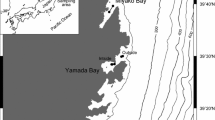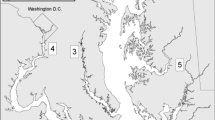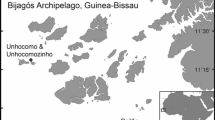Abstract
Traditional approaches to dietary assessment in fish necessitate the collection of stomach contents through either gastric lavage or lethal sampling. The Atlantic bonefish (Albula vulpes) is an economically important sportfish in the western central Atlantic region for which a minimally invasive, non-lethal alternative to morphological dietary assessment would be extremely useful. Here, we compare dietary DNA metabarcoding from cloacal swabs of 16 A. vulpes to dietary composition data obtained using traditional morphological classification techniques and metabarcoding of homogenized stomach contents. Further, we compare the performance of two commonly used barcoding genes (18S rRNA and COI) at inferring A. vulpes diet composition. We found that detection of taxa and the resolution of taxonomic annotation varied between markers, suggesting a multi-marker approach is likely to provide the most complete results. Importantly however, the number of dietary OTUs identified and the taxonomic composition of the core diet were not significantly different between molecular markers. Dietary compositions identified using metabarcoding approaches differed in both diversity and composition from matched dietary data obtained from morphologically analyzed stomach contents; however, the same core prey classes were identified using both methods, suggesting that metabarcoding does indeed offer a viable alternative to morphological dietary assessment. Importantly, dietary compositions identified by metabarcoding of cloacal swabs did not differ significantly from those identified by metabarcoding of stomach contents. Metabarcoding of minimally invasive cloacal swabs should be considered for dietary studies of bonefish and other fish species for which invasive or lethal sampling is problematic.



Similar content being viewed by others
Data availability
Raw sequence data associated with this work are available from the sequencing read archive under BioProject PRJNA874874.
References
Adams AJ (2017) Guidelines for evaluating the suitability of catch and release fisheries: lessons learned from Caribbean flats fisheries. Fish Res 186:672–680. https://doi.org/10.1016/j.fishres.2016.09.027
Adams AJ, Cooke SJ (2015) Advancing the science and management of flats fisheries for bonefish, tarpon, and permit. Environ Biol Fish 98:2123–2131. https://doi.org/10.1007/s10641-015-0446-9
Adams AJ, Horodysky AZ, Mcbride RS et al (2014) Global conservation status and research needs for tarpons (Megalopidae), ladyfishes (Elopidae) and bonefishes (Albulidae). Fish Fish 15:280–311. https://doi.org/10.1111/faf.12017
Araújo MS, Bolnick DI, Machado G et al (2007) Using δ13C stable isotopes to quantify individual-level diet variation. Oecologia 152:643–654. https://doi.org/10.1007/s00442-007-0687-1
Barbour AB, Boucek RE, Adams AJ (2012) Effect of pulsed gastric lavage on apparent survival of a juvenile fish in a natural system. J Exp Mar Biol Ecol 422–423:107–113. https://doi.org/10.1016/j.jembe.2012.04.011
Boucek RE, Rehage JS, Castillo NA et al (2022) Using recreational tournament records to construct a 53-year time series of the Florida Keys recreational Bonefish fishery. Environ Biol Fish. https://doi.org/10.1007/s10641-022-01299-5
Brownscombe JW, Thiem JD, Hatry C et al (2013) Recovery bags reduce post-release impairments in locomotory activity and behavior of bonefish (Albula spp.) following exposure to angling-related stressors. J Exp Mar Biol Ecol 440:207–215. https://doi.org/10.1016/j.jembe.2012.12.004
Brownscombe JW, Danylchuk AJ, Adams AJ et al (2019) Bonefish in South Florida: status, threats and research needs. Environ Biol Fish 102:329–348. https://doi.org/10.1007/s10641-018-0820-5
Buchner D, Leese F (2020) BOLDigger - a Python package to identify and organise sequences with the Barcode of Life Data systems. Metabarcoding Metagenom 4:19–21. https://doi.org/10.3897/mbmg.4.53535
Campbell LJ, Castillo NA, Dunn CD et al (2022) Viruses of Atlantic Bonefish (Albula vulpes) in Florida and the Caribbean show geographic patterns consistent with population declines. Environ Biol Fish. https://doi.org/10.1007/s10641-022-01306-9
Casey JM, Meyer CP, Morat F et al (2019) Reconstructing hyperdiverse food webs: gut content metabarcoding as a tool to disentangle trophic interactions on coral reefs. Methods Ecol Evol 10:1157–1170. https://doi.org/10.1111/2041-210X.13206
Cheng L (1976) Marine insects. North-Holland publishing company, Amsterdam. https://escholarship.org/uc/item/1pm1485b
Colborn J, Crabtree RE, Shaklee JB et al (2001) The evolutionary enigma of bonefishes (Albula spp.): cryptic species and ancient separations in a globally distributed shorefish. Evolution (N Y) 55:807–820. https://doi.org/10.1111/j.0014-3820.2001.tb00816.x
Comeau AM, Li WKW, Tremblay JÉ et al (2011) Arctic ocean microbial community structure before and after the 2007 record sea ice minimum. PLoS One 6:e27492. https://doi.org/10.1371/journal.pone.0027492
Crabtree RE, Stevens C, Snodgrass D, Stengard F (1998) Feeding habits of bonefish, Albula vulpes, from the waters of Florida Keys. Fish Bull 96:754–766. https://spo.nmfs.noaa.gov/content/feeding-habits-bonefish-albula-vulpes-waters-florida-keys
Danylchuk AJ, Danylchuk SE, Cooke SJ et al (2007a) Post-release mortality of bonefish, Albula vulpes, exposed to different handling practices during catch-and-release angling in Eleuthera, The Bahamas. Fish Manag Ecol 14:149–154. https://doi.org/10.1111/j.1365-2400.2007.00535.x
Danylchuk SE, Danylchuk AJ, Cooke SJ et al (2007b) Effects of recreational angling on the post-release behavior and predation of bonefish (Albula vulpes): the role of equilibrium status at the time of release. J Exp Mar Biol Ecol 346:127–133. https://doi.org/10.1016/j.jembe.2007.03.008
Deagle BE, Thomas AC, McInnes JC et al (2019) Counting with DNA in metabarcoding studies: how should we convert sequence reads to dietary data? Mol Ecol 28:391–406. https://doi.org/10.1111/mec.14734
Döbel HG, Denno RF, Coddington JA (1990) Spider (Araneae) community structure in an intertidal salt marsh: effects of vegetation structure and tidal flooding. Environ Entomol 19:1356–1370. https://doi.org/10.1093/ee/19.5.1356
Edgar RC (2010) Search and clustering orders of magnitude faster than BLAST. Bioinformatics 26:2460–2461. https://doi.org/10.1093/bioinformatics/btq461
Edgar RC, Haas BJ, Clemente JC et al (2011) UCHIME improves sensitivity and speed of chimera detection. Bioinformatics 27(16):2194–200. https://doi.org/10.1093/bioinformatics/btr381
Fedler AJ (2013) Economic impact of the Florida Keys flats fishery. Report to Bonefish and Tarpon Trust. https://www.bonefishtarpontrust.org/downloads/research-reports/stories/BTT%20-%20Keys%20Economic%20Report.pdf
Fedler AJ (2019) The 2018 economic impact of flats fishing in the Bahamas. Report to Bonefish and Tarpon Trust. https://www.bonefishtarpontrust.org/downloads/research-reports/stories/bahamas-flats-economic-impact-report.pdf
Foster JR (1977) Pulsed gastric lavage: an efficient method of removing the stomach contents of live fish. Progress Fish-Culturist 39:166–169. https://doi.org/10.1577/1548-8659(1977)39[166:PGL]2.0.CO;2
Gao CH, Yu G, Cai P (2021) ggVennDiagram: an intuitive, easy-to-use, and highly customizable R Package to generate venn diagram. Front Genet 12:706907. https://doi.org/10.3389/fgene.2021.706907
Gibson J, Shokralla S, Porter TM et al (2014) Simultaneous assessment of the macrobiome and microbiome in a bulk sample of tropical arthropods through DNA metasystematics. Proc Natl Acad Sci U S A 111:8007–8012. https://doi.org/10.1073/pnas.1406468111
Giebner H, Langen K, Bourlat SJ et al (2020) Comparing diversity levels in environmental samples: DNA sequence capture and metabarcoding approaches using 18S and COI genes. Mol Ecol Resour 20:1333–1345. https://doi.org/10.1111/1755-0998.13201
Gogarten JF, Calvignac-Spencer S, Nunn CL et al (2020) Metabarcoding of eukaryotic parasite communities describes diverse parasite assemblages spanning the primate phylogeny. Mol Ecol Resour 20:204–215. https://doi.org/10.1111/1755-0998.13101
Griffin LP, Haak CR, Brownscombe JW et al (2019) A comparison of juvenile bonefish diets in Eleuthera, The Bahamas, and Florida, U.S. Environ Biol Fish 102:147–157. https://doi.org/10.1007/s10641-018-0822-3
Guo L, Sui Z, Zhang S et al (2015) Comparison of potential diatom ‘barcode’ genes (The 18S rRNA gene and ITS, COI, rbcL) and their effectiveness in discriminating and determining species taxonomy in the Bacillariophyta. Int J Syst Evol Microbiol 65:1369–1380. https://doi.org/10.1099/ijs.0.000076
Hajibabaei M, Porter TM, Wright M, Rudar J (2019) COI metabarcoding primer choice affects richness and recovery of indicator taxa in freshwater systems. PLoS One 14:e0220953. https://doi.org/10.1371/journal.pone.0220953
Ingala MR, Simmons NB, Wultsch C et al (2021) Molecular diet analysis of neotropical bats based on fecal DNA metabarcoding. Ecol Evol 11:7474–7491. https://doi.org/10.1002/ece3.7579
Jakubavičiute E, Bergström U, Eklöf JS et al (2017) DNA metabarcoding reveals diverse diet of the three-spined stickleback in a coastal ecosystem. PLoS One 12:e018929. https://doi.org/10.1371/journal.pone.0186929
Jepsen DB, Winemiller KO (2002) Structure of tropical river food webs revealed by stable isotope ratios. Oikos 96:46–55. https://doi.org/10.1034/j.1600-0706.2002.960105.x
Jud ZR, Layman CA, Shenker JM (2011) Diet of age-0 tarpon (Megalops atlanticus) in anthropogenically-modified and natural nursery habitats along the Indian River Lagoon, Florida. Environ Biol Fish 90:223–233. https://doi.org/10.1007/s10641-010-9734-6
Kroloff EKN, Heinen JT, Braddock KN et al (2019) Understanding the decline of catch-and-release fishery with angler knowledge: a key informant approach applied to South Florida bonefish. Environ Biol Fish 102:319–328. https://doi.org/10.1007/s10641-018-0812-5
Lu Q, Xiao L, Cheng C et al (2021) Snow leopard dietary preferences and livestock predation revealed by fecal DNA metabarcoding: no evidence for apparent competition between wild and domestic prey. Front Ecol Evol 9:783546. https://doi.org/10.3389/fevo.2021.783546
Martin M (2011) Cutadapt removes adapter sequences from high-throughput sequencing reads. EMBnet J 17:10–12. https://doi.org/10.14806/ej.17.1.200
McMurdie PJ, Holmes S (2013) Phyloseq: an R package for reproducible interactive analysis and graphics of nicrobiome census data. PLoS One 8:e0061217. https://doi.org/10.1371/journal.pone.0061217
Murali A, Bhargava A, Wright ES (2018) IDTAXA: A novel approach for accurate taxonomic classification of microbiome sequences. Microbiome 6:140. https://doi.org/10.1186/s40168-018-0521-5
Murchie KJ, Cooke SJ, Danylchuk AJ et al (2013) Movement patterns of bonefish (Albula vulpes) in tidal creeks and coastal waters of Eleuthera, The Bahamas. Fish Res 147:404–412. https://doi.org/10.1016/j.fishres.2013.03.019
Nagareda BH, Shenker JM (2008) Dietary analysis of batfishes (Lophiiformes: Ogcocephalidae) in the gulf of Mexico. Gulf Mex Sci 26:28–35. https://doi.org/10.18785/goms.2601.03
Nichols RV, Åkesson M, Kjellander P (2016) Diet assessment based on rumen contents: a comparison between DNA metabarcoding and macroscopy. PLoS One 11:e0157977. https://doi.org/10.1371/journal.pone.0157977
Nong W, Qu Z, Li Y et al (2021) Horseshoe crab genomes reveal the evolution of genes and microRNAs after three rounds of whole genome duplication. Commun Biol 4:83. https://doi.org/10.1038/s42003-020-01637-2
Palomo L, Perez AU (2021) 2019 economic impact of flats fishing in Quintana Roo, Mexico. Report to Bonefish and Tarpon Trust. https://www.bonefishtarpontrust.org/downloads/research-reports/stories/economic-assess-flats-fishing-quintana-roo.pdf
Pickett BD, Wallace EM, Ridge PG, Kauwe JSK (2020) Lingering taxonomic challenges hinder conservation and management of global bonefishes. Fisheries 45:347–358. https://doi.org/10.1002/fsh.10438
Quast C, Pruesse E, Yilmaz P et al (2013) The SILVA ribosomal RNA gene database project: improved data processing and web-based tools. Nucleic Acids Res 41:590–596. https://doi.org/10.1093/nar/gks1219
R Core Team (2020) R: A language and environment for statistical computing. R Foundation for Statistical Computing, Vienna, Austria. https://www.R-project.org
Rehage JS, Santos RO, Kroloff EKN et al (2019) How has the quality of bonefishing changed over the past 40 years? Using local ecological knowledge to quantitatively inform population declines in the South Florida flats fishery. Environ Biol Fish 102:285–298. https://doi.org/10.1007/s10641-018-0831-2
Santos RO, Rehage JS, Adams AJ et al (2017) Quantitative assessment of a data-limited recreational bonefish fishery using a time-series of fishing guides reports. PLoS One 12:e0184776. https://doi.org/10.1371/journal.pone.0184776
Sawyer RT, Lawler AR, Oversrteet RM (1975) Marine leeches of the eastern United States and the gulf of mexico with a key to the species. J Nat Hist 9:633–667. https://doi.org/10.1080/00222937500770531
Shokralla S, Porter TM, Gibson JF et al (2015) Massively parallel multiplex DNA sequencing for specimen identification using an Illumina MiSeq platform. Sci Rep 5:9687. https://doi.org/10.1038/srep09687
da Silva LP, Mata VA, Lopes PB et al (2019) Advancing the integration of multi-marker metabarcoding data in dietary analysis of trophic generalists. Mol Ecol Resour 19:1420–1432. https://doi.org/10.1111/1755-0998.13060
Snider AM, Bonisoli-Alquati A, Pérez-Umphrey AA et al (2021) Metabarcoding of stomach contents and fecal samples provide similar insights about Seaside Sparrow diet. Ornithol Appl 124:duab060. https://doi.org/10.1093/ornithapp/duab060
Waraniak JM, Marsh TL, Scribner KT (2019) 18S rRNA metabarcoding diet analysis of a predatory fish community across seasonal changes in prey availability. Ecol Evol 9:1410–1430. https://doi.org/10.1002/ece3.4857
Wickham H (2016) ggplot2: elegant graphics for data analysis. Springer-Verlag, New York, New York. https://ggplot2.tidyverse.org
Wu S, Xiong J, Yu YY (2015) Taxonomic resolutions based on 18S rRNA Genes: a case study of subclass Copepoda. PLoS One 10:e0131498. https://doi.org/10.1371/journal.pone.0131498
Xiong W, Zhan A (2018) Testing clustering strategies for metabarcoding-based investigation of community–environment interactions. Mol Ecol Resour 18:1326–1338. https://doi.org/10.1111/1755-0998.12922
Author information
Authors and Affiliations
Corresponding author
Ethics declarations
All bonefish handling and processing techniques follow the approved Florida International University protocol IACUC-21-058 and permit numbers: SAL-22-2100-SRP, BISC-2021-SCI-0010, EVER-2021-SCI-0025.
Competing interests
Aaron Adams is a Guest Editor of this special issue, but he was not involved in the peer review of this article and had no access to information regarding its peer review. The authors declare no competing interests.
Additional information
Publisher’s note
Springer Nature remains neutral with regard to jurisdictional claims in published maps and institutional affiliations.
Supplementary Information

Figure S1
Stacked bar chart of the percent abundance of dietary prey classes per fish for each molecular marker. (PNG 185 kb)

Figure S2
Stacked bar chart of the percent abundance of dietary prey classes per fish for each sampling method. G = Homogenised gut contents, M = Morphological stomach contents analyses, S = Cloacal swabbing. (PNG 189 kb)
ESM 1
(XLSX 46 kb)
Rights and permissions
Springer Nature or its licensor holds exclusive rights to this article under a publishing agreement with the author(s) or other rightsholder(s); author self-archiving of the accepted manuscript version of this article is solely governed by the terms of such publishing agreement and applicable law.
About this article
Cite this article
Campbell, L.J., Castillo, N.A., Shenker, J. et al. Bone appétit: DNA metabarcoding as a non-lethal alternative to morphological dietary assessment in Atlantic bonefish (Albula vulpes). Environ Biol Fish 106, 337–348 (2023). https://doi.org/10.1007/s10641-022-01328-3
Received:
Accepted:
Published:
Issue Date:
DOI: https://doi.org/10.1007/s10641-022-01328-3




